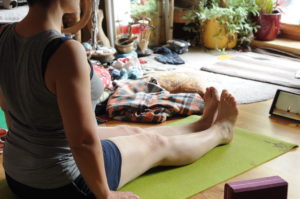
Advice for dealing with grief is everywhere. The Internet abounds with it, friends and family are quick to offer it, and best-selling books are full of it.
As a friend recently reminded me, though, each person’s grief journey is unique. Advice should be replaced with compassion.
Grief charts its own course, but those whom it ferries often pass through the same landmarks: denial, anger, depression, bargaining, and others.
As someone who is traveling with Grief, I remain on the lookout for tools to help me along my way. Mindfulness is one such tool that is repeatedly recommended to me.
According to Google’s definition, mindfulness is “a mental state achieved by focusing one’s awareness on the present moment, while calmly acknowledging and accepting one’s feelings, thoughts, and bodily sensations, used as a therapeutic technique.”
Mindfulness brings acceptance, presence in the moment, calm, peace, serenity, awareness, and unity within one’s self.
This is a rather vague, abstract concept to me. Sometimes I find that considering the opposite of something can help me understand it better.
Although the dictionary may not totally agree with me, the antonym of “mindfulness” is “mindlessness.”
To act out of one’s mind, or mindlessly, is to behave erratically, stupidly, robotically; to automatically cringe or recoil from something and act in a frenzied, hair-brained, ignorant manner. (again, according to Emily’s New Standard Dictionary and Thesaurus for the Self-Reasoning Thinkers)
Mindfulness is a practice. Like any skill, it must be honed and developed in order to be used to its fullest potential.
My favorite mindfulness practices are yoga and guided meditation. The Mayo Clinic offers a brief list of other forms of mindfulness practices here.
Sometimes mindfulness is dismissed as an excuse to pursue shifting desires. While mindfulness does require a peace treaty between our warring inner selves, the agreement is not for absolute surrender.
The key is to use mindfulness to overcome, instead of mindlessly succumbing, to our stumbling blocks.
Practicing mindfulness means accepting even the parts of ourselves that we deem ugly instead of negating their existence. In this way, mindfulness allows us to begin overcoming our weaknesses by first acknowledging them.
The pain of placement is both my weakness and my strength. It is debilitating, yet empowering.
Although my adoption choice has made parts of my life infinitely more difficult, many parts of my life that seemed difficult before are easier now. Perspective is everything.
But while I am in the painful moments, escape is often an appealing option. Mindfulness encourages me to embrace the pain and accept what I’m feeling without trying to change it.
“To know thyself is the beginning of wisdom.” — Socrates
Do you agree with my contrast between being “mindful” and being “mindless”? Have you practiced mindfulness before? If so, did you find it to be beneficial? Leave a reply in the comment box below; please be familiar with the comment policy.
Read more about mindfulness, meditation and yoga:
- “What Is Mindfulness?” by the Greater Good Science Center, University of California, Berkley
- “Benefits of Mindfulness” by Dr. Lisa Firestone, Psychology Today
- “Meditation: A simple, fast way to reduce stress” by The Mayo Clinic
- “76 Scientific Benefits of Meditation” by Giovanni of LiveandDare.com
- “Yoga for Anxiety and Depression” by Harvard Mental Health Letter
- “5 Ways Yoga Benefits Your Mental Health” by Jennifer D’Angelo Friedman, Yoga Journal
